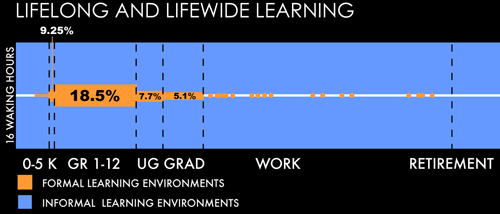In the article “Learning Theories and Education: Toward a Decade of Synergy,” Bransford and colleagues dissect learning from a birds eye view and analyze three aspects underneath the learning umbrella: implicit learning, informal learning, and formal learning. As a teacher, it’s important to be aware of your students and know they come from their own unique experiences before they come to our classrooms. Students arrive at school with varying degrees of abilities, and so much is absorbed during those first few years of life. These experiences help to shape and mold the students sitting in our classrooms. Young children today growing up in our society are inundated with more mobile and accessible technology than any other generation. With the massive presence technologies play in today’s society, students are entering school with preconceived notions of how technology is to be used based on how they’ve observed it being used at home. Without realizing it, young brains are working in overdrive to soak up as much information as possible. Eventually, these learners become imitative. In teaching, there is a phrase “more is caught than taught.” This quote directly aligns with humans’ innate imitative behavior in that students tend to mimic the trusted adults within their inner circle. They pick up on their tendencies.
As illustrated in the image below, much more time during a person’s lifespan are they in informal learning environments than in formal schooling. In fact, the informal learning environment far outpaces formal schooling. This isn’t to say formal schooling doesn’t play a role in student’s development, because it certainly does. Formal schooling comprises roughly 20% of how young people devote their time during the K-12 years, which is a strikingly low number relative to a person’s lifetime. The numbers show that time outside of school without a structured learning path or curriculum to be learned provides even more lessons than ones written on a chalkboard. Learning is dispersed over time across much more informal than formal learning contexts.

Time spent in the classroom is precious and needs to be maximized to its fullest potential. Sharples and colleagues outline in their article “Mobile learning: Small devices, big issues” strong considerations for designing mobile learning experiences. Bransford and colleagues also make dense and robust considerations for designing effective instruction, all of which ping-pong around the heads of teachers and designers alike. Fusing the ideas presented in both of these articles makes for a strong framework to approach mobile learning experiences. A few of my takeaways from these section include adaptive expertise, clarifying for students what success looks like, teaching for transfer and preparation for future learning, conceptual collisions, and metacognitive approaches to teaching. The formal learning environment is already dense with possibilities for teachers to make an impact on students. Tie in the potential to blur the lines between home and school with integration of mobile technologies, and you’re teaching in the future.
Progressive teachers that utilize technology and it’s potential to make learning more personalized and student-centered and student-driven are certainly on the right track. Blended learning models are emerging from the woodworks of how to best implement technologies in classes. However, excessive technology usage could be categorized as too much of a good thing. In Pea’s article “Media use, face-to-face communication, media multitasking, and social well-being among 8- to 12-year-old girls,” the study conducted concluded that 8-12 year old girls with higher levels of of media usage in young girls and multitasking with multiple devices showed lower signs of social-emotional wellbeing. Interactions online and time spent on apps that are meant to foster a social connection can be detrimental to the self-esteem of this population. The outcomes of this study begs a lot of questions for an entire generation growing up digital. Especially with the integration of technologies in day-to-day regularities and in the classroom, media usage should only continue to climb. Beyond that, the study also concluded that the value of face-to-face interaction cannot be understated or substituted by technology. Girls who spent more time in active face-to-face communication reported stronger social successes.
When considering as much of the dense articles simultaneously as possible, the gears in my head just keep churning with new ideas of how to make learning happen effectively for my students. I try to approach my career’s work with a unique perspective with my design research and background knowledge I’m building. Effective strategies for designing mobile learning is totally my jam, and I thirst for new strategies to help me perfect my craft. Teaching in the 21st century requires the exploration and conversation about normalizing using technologies as learning tools in the right ways. School aged students are engaging in media consumption at rates higher than ever before, so designers and teachers should tread lightly with adding to a student’s already crowded digital plate.
- References:
- Bransford, J., Stevens, R., Schwartz, D., Meltzoff, A., Pea, R., Roschelle, J., Vye, N., Kuhl, P., Bell, P., Barron, B., Reeves, B., & Sabelli, N. (2006). Learning theories and education: Toward a decay of synergy. In P. Alexander & P. Winne (Eds.), Handbook of educational psychology (2nd ed., pp. 209–244). Erlbaum. [Course E-Reserves]
- Sharples, M., Arnedillo-Sánchez, I., Milrad, M., & Vavoula, G. (2009). Mobile learning: Small devices, big issues. In N. Balacheff, S. Ludvigsen, et al. (Eds.), Technology-enhanced learning: Principles and products (pp. 233–249). Springer.
- Pea, R., Nass, C., Meheula, L., Rance, M., Kumar, A., Bamford, H., Nass, M., Simha, A., Stillerman, B., Yang, S., & Zhou, M. (2012). Media use, face-to-face communication, media multitasking, and social well-being among 8- to 12-year-old girls. Developmental Psychology, 48(2), 327–336.
